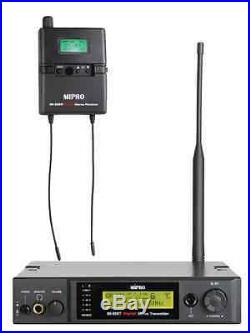
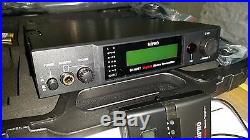
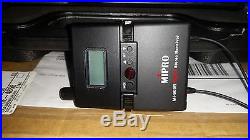
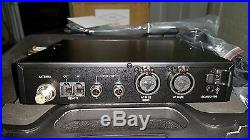
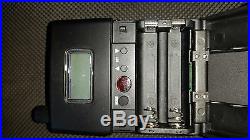
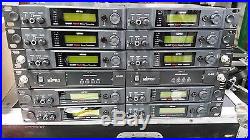
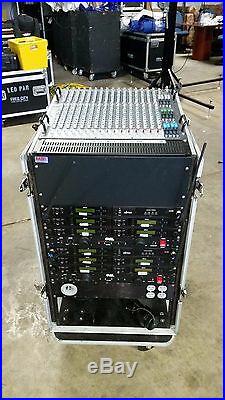

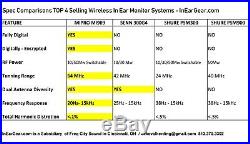
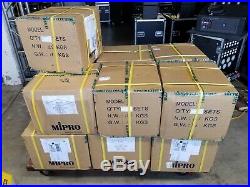

The MI-909T/R system is a professional-quality true digital wireless stereo IEM system featuring digital encryption capabilities with unparalleled digital audio performance and transmission reliability. The superior frequency response characteristics from 20Hz to 15kHz clearly exceed that of analog systems. Combining DSP and digital diversity technologies, MIPRO’s MI-909 system is the industry’s only true digital IEM system. The MI-909 boasts 112dBa of dynamic range, enhanced s/n ratio, extended frequency response and advanced features that provide crystal clear audio that sets a new standard in wireless in-ear monitoring. The MI-909R True Digital bodypack receiver, the most compact in the industry, has dual antenna true digital diversity reception providing unsurpassed RF Signal stability and extended range. The bodypack receiver features Stereo, Mono-L, Mono-R and Mixed operational modes with balance control and equalization settings. The MI-909T True Digital transmitter operates across 64MHz , allowing multiple preset compatible channel operation, adjustable input sensitivity, adjustable RF output and EQ DSP processing built-in. At ineargear I also throw in the back to front antenna (not included here) and a really good set of earphones you can use as a backup. The MiPro 909t/r is a game-changer. I play in a touring band with several wireless mics and a wireless router for a digital mixer already in operation. When I was looking to add some wireless IEM’s to the system, I was concerned about being able to find clear frequencies in multiple RF-heavy environments like NYC and Washington DC since I sometimes have to hunt with our analog systems. Never had a problem with the digital gear though due to the nature of the technology so I was very interested in what the 909 had to offer. I was primarily comparing it to the Sennheiser G4 and the Shure PSM 900, both of which have fewer features and are significantly more expensive. The MiPro offers a huge 64mHz bandwidth for choosing frequencies from vs. Sennheiser’s 42mHz and Shure’s 36-40mHz. Also the Mipro has better low end response at 20Hz-15kHz vs 25Hz-15kHz for Sennheiser and 38Hz-15kHz for Shure. Total Harmonic Distortion is. The real biggie though is that because it’s digital, there is absolutely no companding involved! This means beautiful, full, warm, hardwired-sounding audio from a tiny wireless belt pack with an incredibly low noise floor. The dynamic range is amazing and the low end can feel like subwoofers in your ears with the right mix. The audio is crystal clear and dropout free. I haven’t really pushed the range yet, but I was able to easily get 100 or so yards away through 6 walls and down an entire floor with no change in audio quality. My only concern was whether digital latency would be an issue. Posted latency for the system is 5.84ms. With conventional wedge monitors, I’m already used to hearing about 10ms of latency (I’m 6’5 and I stand maybe 3.5ft from my wedge), so in terms of performance timing, this is actually an improvement. Likewise, anybody playing keys, drums, guitar, bass, etc. Will actually be hearing the sound a few ms sooner than they would from monitors or amps by using the MiPro 909. Even horns (I’m a sax player as well as a singer) present no problem from this amount of latency. I tested by A-Bing the 909 with the direct headphone out on the front channel of my Behringer x32 Rack mixer, both with a wired mic and a Shure PGXD digital mic. In no case did I hear an audible echo so the latency is well under that threshold. With the hardwired mic straight from the front panel as my reference, at very low volumes I could start to hear a little bit of a comb filtering type effect with the hardwired mic through the 909 and a little more with the digital mic. Nothing major, but it was there. However, as I brought the volume up to average performance levels, the sound from the in-ears pretty easily overcame the sound from the bone conduction leaving me with just great digital audio. I think in any scenario where the band is loud enough to require monitors of any kind, latency is really a non-issue here. All in all, this system is a total knockout and I wouldn’t be surprised to start seeing a lot more of them out on the scene as word gets out. MiPro doesn’t have the kind of name recognition in the US that the other big guys do, but since they’re quite literally the only company with a fully digital IEM on the market, they’re bound to start getting some attention soon. Robin Clabby, New Orleans, LA. Joe in New Jersey was concerned about going digital because of the word Latency. He sent me this note. But lets face it most of us in the music business are. Anyway I started to obsess about this whole “latency” issue. Not so much with just the Mipro 909 IEM but the added latency from the X32 Rack and in the near future of a digital guitar wireless. After doing some research on the web and listening to all the. I decided to put it this rest here is what I did and I thought I would share my little experiment with you. This comes to a total of 6.69 ms for wired (guitar & vocal mic) sources and for wireless (guitar & vocal mic) approx 10.69 ms. That latter really scared me on paper. So what I did to replicate this was to set up a Pro Tools HD session using a TDM delay plugin. Keep in mind the Pro Tools TDM rig has from what I have read a 2.4 ms latency at 44.1k. So what I did was insert the stock short delay plugin on the microphone channel and set it to 4.2 ms 6.69 ms (Mipro 909 & X32 Rack) – 2.4 ms (Pro Tools HD rig) = 4.19 I popped in my Shure 425’s to a wired headphone amp and sang into the mic. I did notice a very slight comb filter effect. And as I turned up the volume on the in ears to where I would typically monitor with this was even less noticeable. Furthermore when I added a little bit of reverb to the vocal this became a none existent issue at that point! Next I decided to push the envelope and increase the delay with the plug in a bit. As long as I was below 13 ms – 15 ms total everything seems to be quite usable. I will keep you posted once I have the rig complete. EIA-standard half-rack 19 metal case, LCD screen display, rotary control knob for advanced menu settings and dual audio LED indicator lockable front panel. Up to 16 compatible channels within the same frequency group. Selectable encryption keys with scroll or static setting for single or multiple receivers. Selectable HI, LOW or OFF (mute) output power. High dynamic range, stereo audio inputs and able to withstand the maximum output levels of professional audio mixers. Built-in DSP 3 band ±9 dB EQ settings for audio modifications. Free Scan selects an open, interference-free transmitter frequency and ACT syncs the transmitter and receiver frequencies automatically. Ideal for professional multi-language interpretation system and installation applications. ± 0.005% (-10+60). 20 Hz 15 kHz (stereo). > +26 dBu, Selectable Line / Mic level. 0-30 dB, 3 dB step. RJ-11 × 2, proprietary MIPRO ACT-BUS. Dimensions (W × H × D). 210 × 44 ×. / 8.3 × 1.7 × 8.1. 909R BELT PACK /. The MI-909R operates in a wide 64 MHz bandwidth and it has easy to use controls and indicators with a backlit LCD screen. Advanced dual-antenna diversity design eliminates signal dropouts and enhances signal stability. Featuring a lightweight, exceptionally durable magnesium alloy bodypack case, the MI-909R is ideal for professional installations and live applications. Proprietary digital encryption provides secure audio transmission, preventing unauthorized listening in conferences, meetings and language interpretation applications. Industrys most compact and smallest housing. Featuring a lightweight, yet rugged, magnesium & glass-fiber reinforced plastic case for stage applications. Backlit LCD screen with superior features and advanced function settings. Dual-antenna diversity design enhances RF signal stability and extends transmission range. Dual unbreakable soft antennas. Selectable stereo, balanced, mono & mixed output modes. Fast and easy menu controls and indicators accessed by three buttons. 12 non-interference compatible frequencies in group 1-10. 16 non-interference compatible frequencies in group 11-16. 16 user-defined frequencies can be stored in group 18. 216 preset frequencies in total. 10V input level, S/N > 90dB (stereo). 126 dB (1dB step). Status, Group & Channel, R/L balance. Ø stereo earphone jack. 8 hours (moderate volume). 63 × 82 ×. / 2.6 × 3.2 × 0.9. The item “Mipro MI909 (IN STOCK) Digital Wireless In Ear Monitor System” is in sale since Thursday, June 22, 2017. This item is in the category “Musical Instruments & Gear\Pro Audio Equipment\Speakers & Monitors”. The seller is “zolton2″ and is located in Cincinnati, Ohio. This item can be shipped worldwide.
- Model: MI909
- Country/Region of Manufacture: Taiwan
- Type: In Ear Monitor
- MPN: MI909
- Brand: MIPRO

